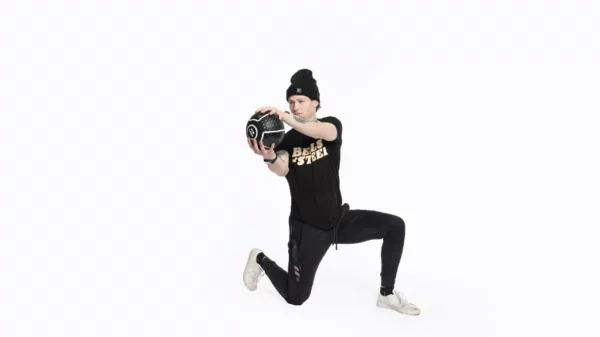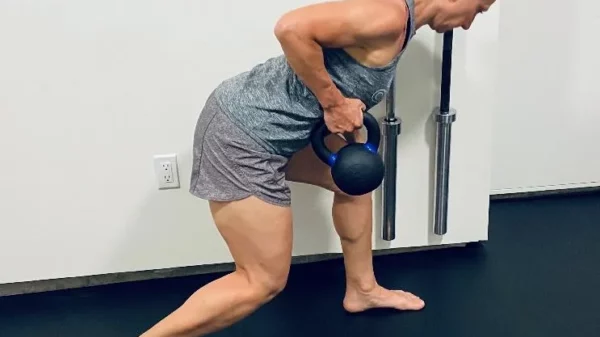All the leg strength in the world doesn’t mean much if your knees feel like they’re on fire or being stabbed every time you try to bend them. When it comes to squats, there’s a lot of knee-bending going on. If you try to push through the pain, you may be staring down the barrel of a very short lifting career.
Knee pain while squatting is often caused by insufficient warm-ups, poor form, or underlying issues with tendons and tracking.
This article will help you prevent all of that from happening. Let’s look at the common reasons why knees can hurt when you squat and how you can get the issue under control — whether you’re performing standard barbell squats, squatting with a specialty barbell, or performing weighted goblet squats.
Reason 1: Your warm-ups are lousy
Let’s start with a low-hanging fruit: knee pain can be easily corrected if it’s related to a poor (or absent) warm-up routine. Simply jumping into some heavy squats the moment you walk into the gym is a recipe for knee pain while squatting—especially if you’re no longer in your early twenties (or younger).
A proper and effective warm-up will help increase the temperature of your muscles (by increasing the amount of blood flow within them). This effect helps improve the fluid dynamics around the muscles and tendons and the elastic properties of these tissues. [1],[2]
That’s a fancy way of saying that a good warm-up will reduce the stiffness of the muscles and tendons around your knees and allow them to move more smoothly and efficiently. The result will be less pain, better movement, and better lifting performance.
How to perform a good warm-up
To perform a good warm-up, you’ll want to start with a continuous low-intensity movement for a few minutes (five minutes should suffice). This movement will increase your heart rate and blood flow into your legs and around your knees.
The Blitz Airbike is the perfect full-body piece of warm-up equipment since it will maximize blood flow throughout all four extremities. Rowing machines also work great. Just work with what you’ve got (but make sure it doesn’t bother your knees in the process).
From there, pick a handful of dynamic movements (not static stretches) for your lower body and perform these movements for another few minutes. These movements will prepare your knees and hips for your upcoming squats and other exercises.
Some of my favorite lower-body dynamic movements include:
- Body weight squats
- Side lunges
- Light kettlebell swings
A good dynamic warm-up should have you break a light sweat. Once you’ve done a few minutes of continual movement and some light dynamic movements, your knees should feel prepared for a few warm-up sets using the bar.
It’s a good idea to have a dedicated warm-up routine even if your knees don’t hurt when squatting. Your routine will likely improve your body’s physical performance abilities.
As a bonus tip, consider wearing a pair of neoprene knee sleeves if you want your knees to stay as warm as possible. Many lifters opt to wear knee sleeves, with one of the primary reasons being that they help retain heat in and around the knee joint in addition to the sensory feedback they provide.
Reason 2: Your technique is off
The average person would never realize that squatting can be incredibly technical, especially when bearing weight. Even little imperfections or inconsistencies with your squatting can lead to aches and pains.
While there can be dozens of squat technique issues that lead to pain, the most common issues include:
- Your heels lifting off the ground
- Your knee(s) caving inwards
- Your depth is excessive for your abilities
Let’s look at these in a bit more detail.
Your heels are lifting off the ground
There are several reasons someone’s heels might lift off the ground during a squat. We won’t cover the specific causes in this article — though poor ankle mobility is often the issue— just know that your heels should always stay on the floor with traditional squats.
When your heels lift during the squat, a significant amount of force runs through the front of the knee — particularly through the quadriceps tendon and the patellar tendon. This shift can place excessive demand on these tendons, straining the tissues and causing pain.
The quadriceps tendon and patellar tendon are located at the front of your knee, just above and below the kneecap, respectively. As such, lifting the heels when squatting usually causes pain in the front of the knee around the kneecap.
If you’re prone to lifting your heels off the ground when squatting, you can place them on a board, like a 2×4 or 2×6. Small plates, like a five or 10-pound plate, also work.
Squatting with your heels on an elevated surface can help compensate for the mobility issues that often cause a lifter’s heels to rise during the squat. The heel support will reduce the excessive force running through the front of your knee.
Dedicating time in your warm-up to focus on ankle mobility and calf flexion will also help improve your squat technique.
Your knee or knees are caving inwards
The knee is a hinge joint, meaning it primarily operates in one plane of movement (bending forwards and backward). Knees don’t tolerate sideways movements, and they certainly can’t produce much force this way, either.

When one (or both) of the knees cave in, there can be an increased amount of stress placed on the inside of the knee. Note how this photo shows my right knee collapsing inwards, so it’s no longer stacked directly above my foot.
A safe and effective squat requires the knees to be stacked vertically over the shinbone at all times. When one or both of the knees cave inwards during a squat, it generates a sideways force (known as a valgus force)on the knee. The valgus force stresses the joint and the tissues that cross over it. This issue is very common among new lifters.
Performing repetition after repetition of squats with one (or both) knees caving inwards will irritate the joint and soon become painful. Not to mention, you’ll have an inefficient squat. Most lifters who experience knee pain from the valgus squat collapse feel the pain on the inside portion of the knee—the area where the joint is stressed to the greatest extent.

With a good stack, the knees won’t cave inwards and will remain stacked directly above your feet.
Watching yourself squat in the mirror is the best way to see if your knees are collapsing. Visual feedback is often a highly effective way to clean up these issues.
If you don’t have a mirror to squat in front of or find that it’s not fixing the problem, it may help to “rip the floor apart” while squatting, as if you were trying to spread your legs away from one another. In other words, cue yourself to push your knees outward.
With this technique, you’ll get better gluteal muscle engagement, which will help to prevent your knees from caving inwards, reducing knee pain while squatting. This technique works like a charm for many of the patients and athletes I rehab!
Your depth is excessive for your abilities
Deep squats are not inherently bad. Like any other exercise, each person needs to know how to modify movements and ranges of motion based on what their body can tolerate. Saying that every person should squat to the same depth is like saying every person should eat the same diet; it’s myopic and doesn’t account for the unique needs, abilities, and tolerances of each individual’s body.
Deeper squats require more extensive mobility from the muscles and tendons that work to bend and straighten your knees. Additionally, deeper squats require the knee joint to articulate in ways that can irritate the joint cartilage if the knees aren’t perfectly healthy.
If your knees seem to act up or just don’t tolerate deeper depths, don’t sweat it. Work within a comfortable range for your knees while keeping each squat slow and controlled. While working on building leg strength and moving through large ranges of motion is incredibly important, squats aren’t the only way to achieve these objectives.
Other tried-and-true leg exercises you could try might include:
- Kettlebell swings
- Split squats
- Deadlifts
The key is to experiment with your squats and other exercises to find out what best suits the abilities of your knees (and the rest of your body). Smart lifters are never afraid to individualize their exercises and workouts to suit their needs.
Reason 3: You have tendinopathy
Tendinopathy is an umbrella term for a tendon that is unhealthy. A tendon is a thick, gristly tissue that anchors the end of a muscle onto the bone. There are two primary tendons of the knee to focus on in this article: the patellar tendon and the quadriceps tendon.

Quadriceps tendon pain is typically perceived above the kneecap, whereas patellar tendon pain is typically perceived below the kneecap.
The patellar tendon runs from the bottom of your kneecap (patella) down to the top of your shinbone (tibia). The quadriceps tendon runs from your quadricep muscles at the bottom end of your thigh to the top of the patella (kneecap).
Tendinopathy includes conditions such as tendonitis, tendinosis, and a few others.
Tendonitis is much rarer than we once thought it to be. Most lifters with tendon issues fall into the category of tendinosis.[3],[4] Of course, I don’t know what you’re dealing with. Assuming it’s an ongoing problem (not brand new) and one that presents as an on-and-off again issue (sometimes hurts and sometimes doesn’t), it’s likely tendinosis.
Dealing with unhealthy tendons
Tendinosis can be stubborn to deal with; however, it’s usually a straightforward process. Tendons don’t fully recover when only rested and remain vulnerable to being overworked due to their incomplete recovery.
The goal is learning how to load and challenge the tendon to stimulate a return to full health without overworking it — which is beyond the scope of this article. You can likely use squats as the actual rehab exercise for this process, but you will need to modify your squat parameters accordingly.
Your best bet is to find a qualified healthcare practitioner who understands the nature of these conditions and your needs as a lifter and active individual.
Reason 4: You have tracking issues (PFPS)
The underside of the kneecap’s surface has a particular shape which allows it to fit perfectly in the notch between the bumpy knobs on the bottom of your femur (the thigh bone). These rough knobs are known as the femoral condyle, and the notch between them is called the intercondylar groove.
Since all four of the quadriceps muscles converge onto the common quadriceps tendon, which then attaches to the top of the kneecap, each one pulls from a slightly different angle.
Suppose one quadriceps muscle is tight or another is not strong enough. In that case, the kneecap can be pulled in a manner that causes its underside to no longer sit perfectly within the intercondylar groove. Instead, it will rub against the side of the groove— which is highly irritating to the kneecap.
This is known as a patellar tracking issue. It’s essentially like having the tires on one side of your car under-inflated while the tires on the other are over-inflated.
Patellofemoral pain syndrome (PFPS) usually responds quite well to conservative treatment. Consider implementing the following strategies:
- Strengthen your glute medius and glute minimus muscles (on the side of your hip).
- Perform soft tissue treatments (such as foam rolling or massage therapy) to the outside of your thigh, targeting your IT band and your vastus lateralis (the quadriceps muscle on the outer region of your thigh).
Commit yourself to improving the mobility of your IT band and quadriceps for a few weeks, and you’ll likely start to feel a positive change in your condition. It’s also beneficial to foam roll, target, and mobilize your leg muscles immediately before your leg session, as this can help improve knee tracking during your workout session.
Overcoming knee pain while squatting
Knee pain when squatting is quite common, but that doesn’t make it normal. Pushing through this pain is a mistake.
Take the time required to determine what your knees will (and won’t) tolerate. From there, you can take the necessary steps to get back to training in meaningful, fulfilling, and pain-free ways.
Disclaimer: None of this is medical advice and is for informational purposes only; please seek an assessment from a qualified healthcare professional for any pain you may be experiencing.
This is a guest post by Jim Wittstrom. Jim is a physiotherapist and strength & conditioning specialist currently practicing in Calgary, Alberta, Canada. His passion is to help others overcome their physical pain and come back stronger than before. For more great info, you can find him on Strength Resurgence.
References:
- Opplert J, Babault N. Acute effects of dynamic stretching on muscle flexibility and performance: an analysis of the current literature. Sports Med. 2018;48(2):299-325.
- Woods K, Bishop P, Jones E. Warm-up and stretching in the prevention of muscular injury. Sports Med. 2007;37(12):1089-1099.
- Scott A, Backman LJ, Speed C. Tendinopathy: update on pathophysiology. J Orthop Sports Phys Ther. 2015;45(11):833-841.
- Millar NL, Murrell GA, McInnes IB. Inflammatory mechanisms in tendinopathy–towards translation. Nat Rev Rheumatol. 2017;13(2):110-122.








